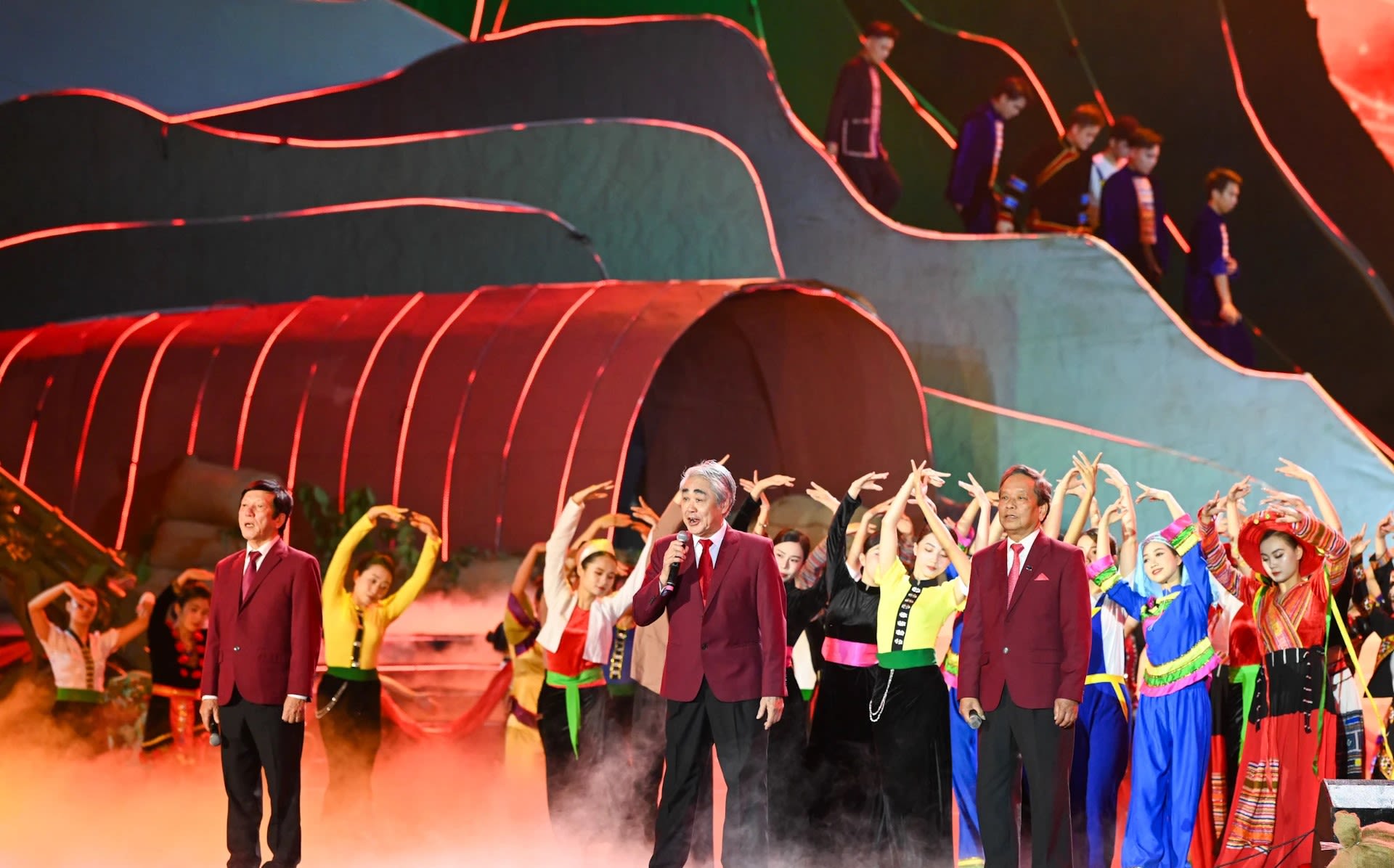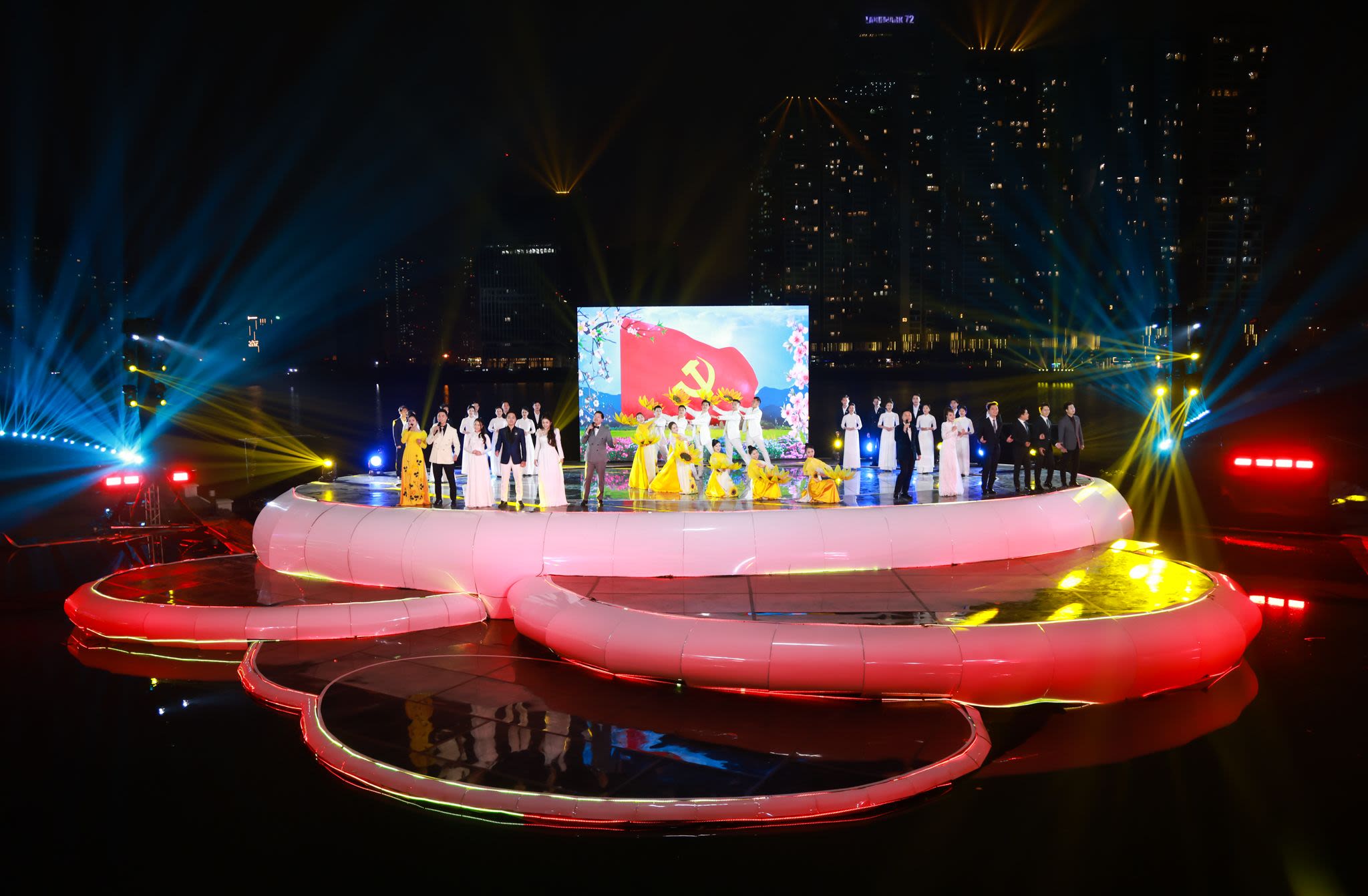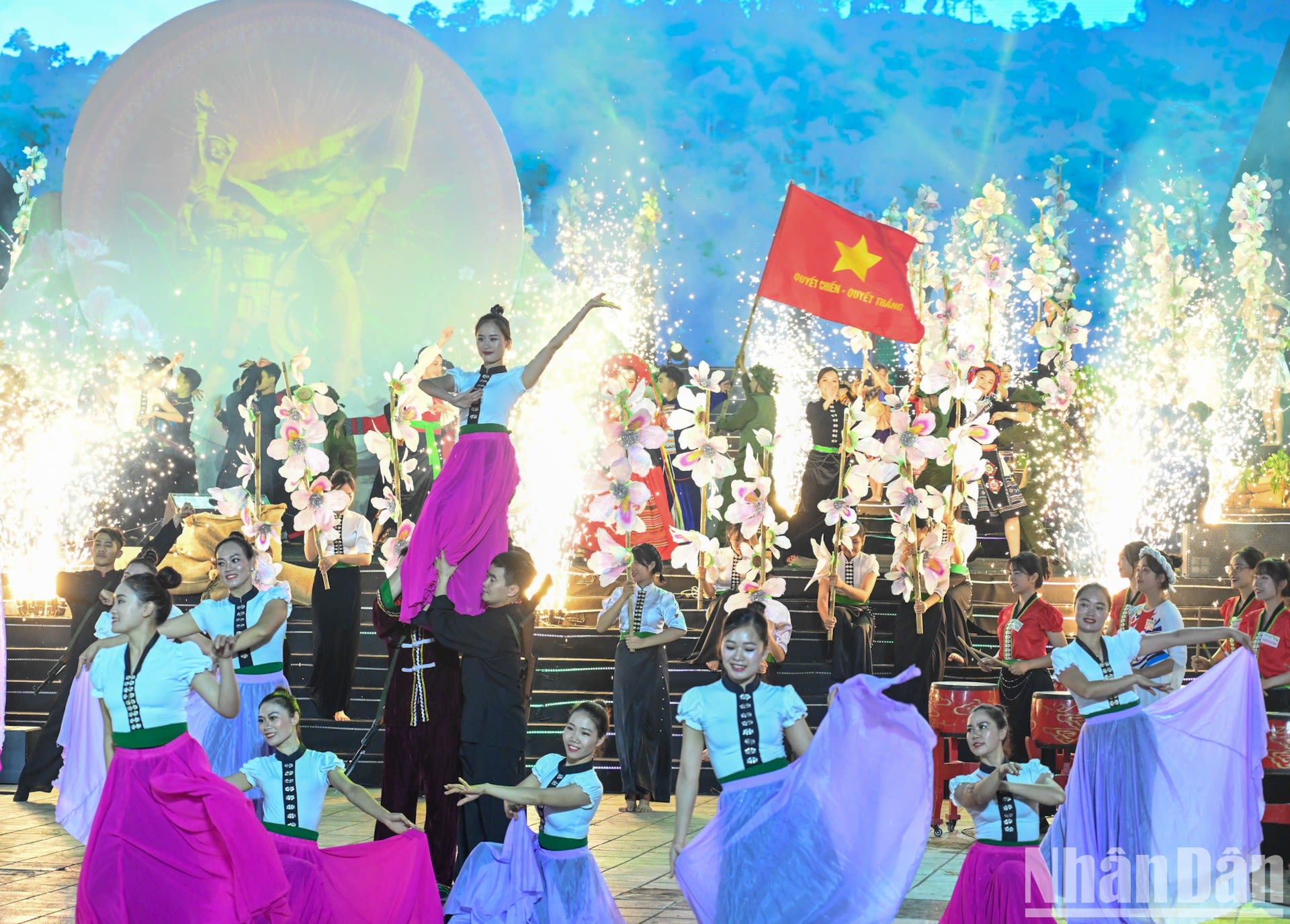Songs about the Party in the stream of national music
As of spring 2025, the Communist Party of Vietnam has accompanied national history for 95 years with many glorious achievements. Among the factors contributing to these victories are the artists and writers who have made significant contributions.
Through their love and responsibility for the country, the Party and the nation’s destiny, and from the vibrant reality of life, poets and musicians have dedicated themselves tirelessly and effectively, creating many works about the Party with undying faith, optimistic spirit, and pride in the glorious Party. Notably, every Lunar New Year and spring, when songs dedicated to the Party and celebrating spring are broadcast across mass media, every Vietnamese person’s heart swells with pride and emotion.
The songs that accompany 95 springs of the Party

History shows that songs about the Party have consistently emerged alongside the Party’s birth and growth. During the revolutionary movement of 1930-1931, which peaked with the Nghe Tinh Soviet Movement, composer Dinh Nhu (1910-1945) created a piece praising the Party’s mighty army, titled “Cung Nhau Di Hung Binh” (March Together as a Mighty Army).
With concise, memorable and easily understood lyrics, the song serves as the Party’s call to the people: “March together as a mighty army, moving forward with one heart. Don’t let the enemy escape, we are determined to sacrifice ourselves and advance towards unity...”
In 1945, at just 15 years old, the Party led our people in revolutionary struggle and, when the time came, rose up to create the August Revolution, overthrowing the feudal regime and the rule of French colonialists and Japanese fascists, establishing the Democratic Republic of Vietnam, the first worker-peasant state in Southeast Asia. This heroic historical reality of our people further affirmed the role and faith in the Party’s leadership. Simultaneously, it inspired musicians to compose many songs about the Party.
In February 1951, the Indochinese Communist Party held its 2nd National Congress in Chiem Hoa District, Tuyen Quang Province. At this congress, the Party changed its name from the Indochinese Communist Party to the Vietnam Workers’ Party and began operating publicly. Immediately afterward, in Thai Nguyen Province, musician Do Minh (1926–2008) promptly composed the song “Chao mung Dang Lao Dong Viet Nam” (Welcome the Vietnam Workers’ Party), later renamed “Chao mung Dang Cong san Viet Nam” (Welcome the Communist Party of Vietnam). The lyrics of this song are filled with joy, emotion, and pride: “The eastern sky, the rosy light shines bright/ A flock of white doves returns in the new sunlight/ Millions of people join hands with the Communist Party of Vietnam/ A solid bloc of workers and farmers united as one…”
The art programme “Mua Xuan Do” (Red Spring) by Hanoi Radio and Television celebrates the Party’s 95th anniversary.
The art programme “Mua Xuan Do” (Red Spring) by Hanoi Radio and Television celebrates the Party’s 95th anniversary.
Five years later, in Hanoi, musician Thanh Phuc (1933–2020), recalling the days of resistance spent in the Viet Bac forests under the protection, care, and support of the Meo (H’mong) ethnic people in Ha Giang Province, composed the unique song “Nguoi Meo on Dang” (The Meo people are grateful to the Party). This song also served as propaganda by the local government and border guards, promoting the Party and Government’s correct policies to the Meo people.
In 1975, when the entire nation shared the joy of the South’s liberation and the country’s reunification, numerous songs about the nation and the Party were composed by musicians. Notable among them are “Viet Nam oi, mua Xuan den roi” (Vietnam, Spring has come) by musician Huy Du (1926–2007) and “La co Dang” (The Party flag) by musician Van An.
A performance from the Dien Bien Phu - Moc Vang Lich Su (Dien Bien Phu - The Historic golden milestone) art programme.
A performance from the Dien Bien Phu - Moc Vang Lich Su (Dien Bien Phu - The Historic golden milestone) art programme.
Notably, the song “Dang la cuoc song cua toi” (The Party is my life) by musician Nguyen Duc Toan conveys his deep emotions and unwavering faith in the Party: “The Party is my life/ Forever I follow you/ Since childhood, when I knew nothing of hardships/ The Party gave me purpose and belief/ Amidst the vast sea, where is the shore? The blue sky I had never seen before.”
Composer Nguyen Duc Toan once shared: “This is my sentiment, the voice of my heart to the Party, and also the voice of everyone at that time towards the Party. It is something intimate, naturally connected by blood. As in the lyrics, I write songs about the Party because the Party is my life. I want to tell myself, my comrades, and my compatriots about the feelings of a revolutionary soldier, of every citizen towards the Party. The Party gives me a personality, a direction, and a belief. The Party's ideals have deeply permeated my flesh and blood; the melody about the Party resounds from my heart.”
Musician Pham Tuyen at his daughter Pham Hong Tuyen’s book launch ceremony.
Musician Pham Tuyen at his daughter Pham Hong Tuyen’s book launch ceremony.
Pham Tuyen is one of the few composers with many great songs about the Party. He is also one of the famous composers capable of writing diverse songs about the Party, President Ho Chi Minh, and the love for the homeland. With the theme about the Party, he has a series of great songs such as ‘Mau Co Toi Yeu’ (The Flag I Love), ‘Dang Da Cho Ta Mua Xuan’ (The Party Has Given Us Spring), and ‘Dang Da Cho Toi Sang Mat Sang Long’ (The Party Has Given Me Light in My Eyes and Heart).
In 1959, upon encountering a poem by the French communist poet Louis Aragon translated by poet To Huu in a newspaper, composer Pham Tuyen set it to music, creating the song ‘The Party Has Given Me Light in My Eyes and Heart’. Exactly one year later, on the occasion of the 30th anniversary of the Party's founding (1930-1960), which was also the year our Party decided to take February 3 as the Party's founding anniversary, composer Phạm Tuyen continued to write the second song ‘The Party Has Given Us Spring’, which was inspired by the poem of the French communist poet Paul Vaillant-Couturier, “Communism is the Spring of humanity.”
The song ‘The Party Has Given Us Spring’ (Nhan Dan TV)
The song ‘The Party Has Given Us Spring’ (Nhan Dan TV)
The lyrics “The Party has given us a spring full of aspirations” express the elation of the whole country celebrating the glorious 30th anniversary of the Party (1930-1960), and it is also the greetings of the Party to the entire army and people stepping into the new year. To this day, it remains an immortal song that touches millions of Vietnamese hearts.
A touching performance by singer Tung Duong and war veterans at the ‘Aspiration for Peace’ art programme.
A touching performance by singer Tung Duong and war veterans at the ‘Aspiration for Peace’ art programme.
In 1979, when the war to protect the northern border against Chinese invaders broke out, musician Pham Tuyen composed a poem by poet Diep Minh Tuyen to write the song “Colour of the Flag I Love.” The most special thing about this musical work of his is that he wrote about the Party but did not mention the single word “Party”; he only talked about the national flag, but when the melody rang out, everyone understood that it was talking about the Party flag.
Meanwhile, the song “The Party Flag” was written by musician Van An (1929-2011) in 1975 when the South was just liberated and the country was unified. The song contains pride, steadfast faith in the Party flag, and firm belief in the final victory to follow the Party for life. With just simple lyrics, the song still arouses pride in the hearts of every Vietnamese child about the history of building and defending the country: “The country of four thousand years, oh how proud/ Happiness in our hands is blooming and bearing fruit/ What is more beautiful than the red flag of hammer and sickle/ Our Party is joyful with a belief”.
In 1976, musician Nguyen Duc Toan (1929-2016) composed the song “The Party is my life” when the country was unified and reunited. “The Party is my life/ Forever following Him/ Since childhood, my life has not been used to the storms/ The Party has given me the reason to live, the faith, in the middle of the ocean, where is the shore/ The blue sky has never been seen…” The lyrics not only contain the love for the people and the Party, but it is also like a bold declaration: The Communist Party of Vietnam is like the flesh and blood of the people, always existing in the hearts of the people and the Vietnamese nation.
Musician Nguyen Duc Toan once shared that he wrote many songs about the Party, even at each Party congress. The inspiration for him to write this song came very naturally and he also shared: “When writing about the Party, people rarely write in a lyrical style, but the song “The Party is my life” was created from that style, not in the exciting, bustling, majestic rhythm of many other songs written about the Party”. Perhaps that is one of the reasons why the song “The Party is my life” is one of the songs that won the Ho Chi Minh Prize for Literature and Arts in 2000.
Those familiar and famous songs are often performed in ceremonies, conferences, congresses, and political art programmes to affirm and honour the Communist Party of Vietnam. Every time those songs are sung, the singers and the audiences are aroused with pride and confidence to contribute to the country, the people, and the Party.
Singers associated with songs about the Party

After the August Revolution in 1945, Vietnam had a generation of well-trained, skilled singers, many of whom were trained abroad. Their names were associated with songs praising the Party. Many singers later became lecturers at professional music schools, training the next generations, were awarded noble titles such as People's Artist, Meritorious Artist, and won many domestic and international music awards.
People's Artist Trung Kien.
People's Artist Trung Kien.
We can mention the "big trees" of Vietnamese music such as People's Artist Quoc Huong, Meritorious Artist Tran Thu, People's Artist Tran Chat, People's Artist Tran Khanh, People's Artist Quy Duong, Meritorious Artist Quang Hung, People's Artist Tran Hieu, Meritorious Artist Kieu Hung, People's Artist Trung Kien, People's Artist Doan Tan, People's Artist Quang Tho, Meritorious Artist Duong Minh Duc, Meritorious Artist Tien Thanh, Meritorious Artist Trung Duc.
Female artists such as People's Artist Thuong Huyen, Meritorious Artist Tan Nhan, People's Artist Tuong Vy, People's Artist Thanh Huyen, Meritorious Artist Bich Lien, Meritorious Artist Vu Dau, People's Artist Thanh Hoa, People's Artist Le Dung, People's Artist Thu Hien are all associated with songs praising the Party, praising Uncle Ho, praising the revolution.
The following generations have artists whose names are associated with revolutionary music, such as Meritorious Artists Quang Ly, Tuan Phong, Ta Minh Tam, Thanh Thuy, Dang Duong, Viet Hoan, artists Trong Tan, Anh Tho, Lan Anh, and young artist Vu Thang Loi.
The trio Trong Tan - Viet Hoan - Dang Duong. (Photo: VNA)
The trio Trong Tan - Viet Hoan - Dang Duong. (Photo: VNA)
Many famous artists have been associated with songs praising the Party, becoming classics whenever these songs are mentioned, such as People's Artist Quoc Huong, famous for the songs 'Tinh Ca' (Hoang Viet), 'Tieu Doan 307' (Nguyen Huu Tri - Nguyen Binh), 'Binh Tri Thien Khoi Lua' (Nguyen Van Thuong), or People's Artist Tran Khanh associated with the songs 'Toi La Nguoi Tho Lo', 'Nguoi Chien Si Ay' (Hoang Van), 'Binh Tri Thien Khoi Lua' (Le Thuong), 'Ha Noi Niem Tin Va Hy Vong ' (Phan Nhan), "Thanh Pho Hoa Phuong Do' (Luong Vinh - Hai Nhu).
Additionally, we can mention People's Artist Quy Duong, one of Vietnam’s first opera singers, whose name is closely associated with songs such as "Chao song Ma anh hung" (Hello Heroic Ma River) by Xuan Giao, "Bai ca Ho Chi Minh" (The Ballad of Ho Chi Minh) by Van Cao, and "Tinh em" (Your Love) by Huy Du. Meanwhile, People's Artist Tuong Vy is famous for the songs "Tieng dan Ta Lu" (Ta Lu Sound) by Huy Thuc, "Co gai vot chong" (The Girl Sharpens Thorns) by Hoang Hiep with its poem by Molovklavi, "Bong cay Ko-nia" (Shade of Ko-nia Tree) by Phan Thanh Nam with its poem by Ngoc Anh. In addition, People's Artist Thanh Hoa is famous for the songs "Giua Mac Tu Khoa nghe cau ho Nghe Tinh" (Hearing Nghe Tinh Folk Songs in Moscow) by Tran Hoan, "Bac Ho mot tinh yeu bao la” (Uncle Ho With a Great Love) by Thuan Yen, and "Duong tau mua xuan" (Spring Train Line) by Pham Minh Tuan.
Mentioning People's Artist Quang Tho, a son of the mining land of Quang Ninh, immediately brings to mind the lyrics “Toi la nguoi tho lo, sinh rat ren dat mo, trong nhung ngay co do tung bay tren nui Bai Tho” (I am a coal miner, born on this mining land, in the days when national flags waved over Bai Tho Mountain)."
An interesting aspect of each era is the presence of iconic "Red Music" ensembles, such as People's Artists Quy Duong, Tran Hieu, Quang Tho, Quang Hung, the trio Dang Duong – Viet Hoan – Trong Tan, or the duet Trong Tan – Anh Tho.
A performance in the "Mua xuan do" art programme. (Photo: Quoc Thanh)
A performance in the "Mua xuan do" art programme. (Photo: Quoc Thanh)
Over the past 95 years, the Communist Party of Vietnam has stood alongside the nation, and every victory of the country has been closely tied to the Party’s great role. Songs about the Party not only energise us but also instil faith while inspiring and empowering millions of Vietnamese to march forward under the Party’s flag. These melodies have been accompanying the country on its path of renewal, strengthening our confidence in the future, and guiding us into a new era with aspirations to rise.
The Spring in this Lunar New Year of Snake 2025 is a special one as it is not only the beginning of a new year but also the dawn of a new era filled with the nation's aspirations to rise. Vietnam, Spring has arrived!
Published: February 2025
Content: TRAN TRUNG HIEU, HONG MINH, TUYET LOAN
Translation: NDO
Photos: NDO, VNA, the figures
Media: NGUYEN TRUNG HIEU
Design: NDO








